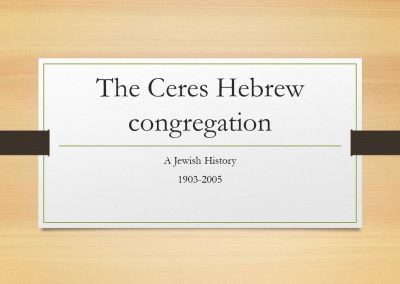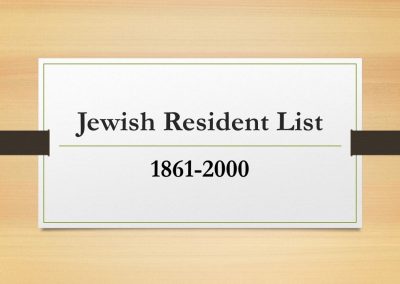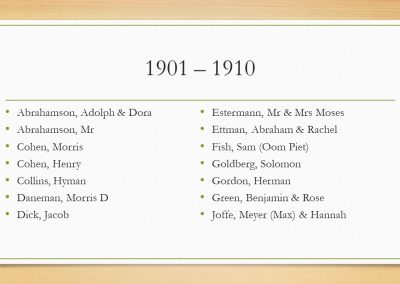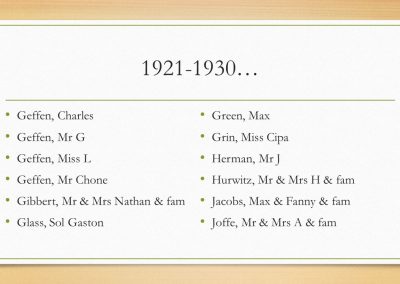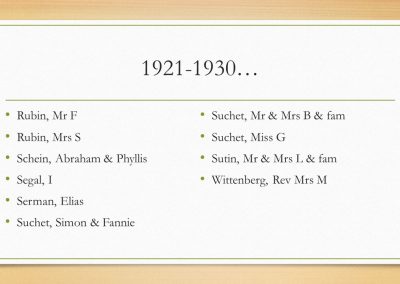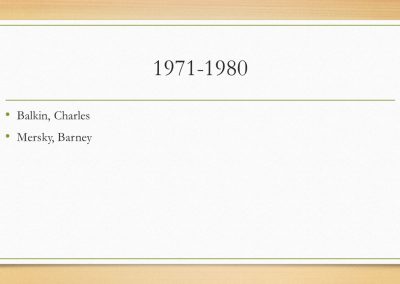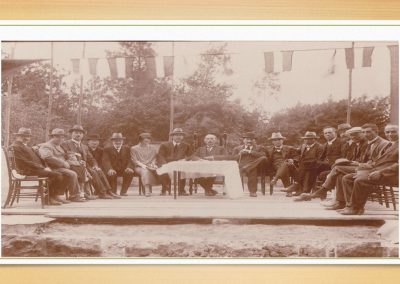Jewish History
The first Jews to settle in Ceres were of German origin. Mr Adolf Arnholz, a storekeeper, was living in the town with his wife Mary by 1865. Their son Harry was circumcised by Rev Joel Rabinowitz in 1868. This may have been the first birth milah in the town. Mina Hotz was born to Adolph and Mary Hotz in Ceres in 1869. By 1870, Adolf Arnholz had been joined by his brother Mr B Arnholz. An early Jewish trader, Ludwig Wiener, traded in Ceres and Tulbagh between 1855 and 1870. He lived in Tulbagh for a period but it is not known if he ever lived in Ceres.
Two Baumann men were recorded in Ceres in the early days and there is a possibility that they may be one and the same person. A Mr Baumann arrived in Ceres in the late 1870s and by 1893 was owner of one of the nine shops in the town. He was still living there in 1923. Michaelis Baumann of Schneidermuhl Prussia, came to the town in the late 1887 and left for Cape Town in 1896. Mr and Mrs B Ring were living in Ceres when their daughter Chiah Faiga was born in 1889. Adolph and Amelia Sebba arrived in the Cape from Russia in 1895 and settled in Ceres. Mr Herman Daneman arrived in the Cape around 1892 and he and his wife had moved to Ceres by 1898. In that year, Lazarus Goldberg and Abraham Hillel Miller co-founded the Ceres Tikvah Zion Society. Mr C Fisch, Morris Green, Mr Katzen and the two Frank brothers were living in the town around 1900.
The Ceres Hebrew congregation was formed around 1903. It reached its peak of 30 families in the 1920s. The Ceres synagogue was built in 1923 on the corner of Porter and Munnik Street opposite the Belmont Hotel. The foundation stone was laid by Mr Baumann, chairman of the congregation at that time. By the 1930s, the synagogue served a large Jewish community that included the Jews of Wolseley. A hall was built in 1933 with the aid of a building fund established by the Ceres Zionist Association in 1925, whereas the land had been purchased a year earlier with funds provided by the Ladies Benevolent Society. The congregation of Ceres, Wolseley and Tulbagh were amalgamated in 1944 under the chairmanship of Mr M Friedman who remained chairman until his death in 1947. This congregation also included the Jews of Prince Alfred Hamlet. At the time of the amalgamation, there were three to four minyanim on High Holy days. In 1953 the congregation, which numbered 21, received a Silver Yad (pointer) from the SAJBD as part of their distribution of ceremonial silver, which had been located by the Nazis and was found in Germany after the war. When Rev Natas left for Cape Town in 1953, Mr Wilf Metter, gabbai of the shul, took over many of the duties of the minister, including conducting all the services. Very little is known about arrangements for shechita in Ceres. The local butchery had a “kosher corner” at one time. In 1958 kosher meat was obtained from Worcester. In 1964 the Ceres-Wolseley Hebrew congregation numbered 17 families. The September 1969 earthquake badly damage the synagogue and hall, which had to be condemned. The three Sifrei Torah were salvaged and housed in the original Aron Kodesh, which had been used before the shul was built. After the disaster, prayers were conducted in a temporary steel construction.
A new Ceres-Wolseley synagogue and communal hall were consecrated on 31 January 1973. This occasion was attended by all members of the community and visitors from Cape Town and neighbouring centres. Wolf Metter unveiled the plaque and Rabbi Prof J Newman officiated, assisted by Cantor Philip Badash and the choir of Green Point and Sea Point Hebrew Congregation.
The Kahn family of Prince Alfred Hamlet celebrated the batmitzvah of Jackie, daughter of Jos and Gwen Kahn, and Robyn, daughter of Michael and Maureen Kahn, in the Ceres synagogue in 1985 and 1987 respectively. At this time the congregation comprised two families each from Ceres and Wolseley, three from Prince Alfred Hamlet, and one each from Drostdy and the Koue Bokkeveld region.
By 1994 the synagogue was used only once a year, on Yom Kippur, and an attempt was made to sell it in the late 1990s. However, by February 1999 it had not yet been sold and was let to a school. The items which were removed from the building were stored on the farm Odessa (near Prince Alfred Hamlet) belonging to Lionel and David Cohen, sons of Colin and Lorraine. Today, the benches and one of the bimah cupboards are to be found in the restored Hermanus synagogue. In addition, a Jewish corner has been set aside at the local town museum where some of the artefacts, including the parochet and luchot are now kept.
A Talmud Torah was active in Ceres and classes took place in the shul hall when it was completed in 1933. In 1958, there being no minister in Ceres, Mrs Har-Chen of Worcester gave cheder classes once a week to ten children of the combined community of Ceres and Wolseley. By 1971, 12 of the community’s children were at the Herzlia School hostel in Cape Town. However, cheder classes were still held in Ceres twice a week by another Worcester teacher. During 1977 Rev Eitan Holtzman, resident minister of Wellington, travelled to Ceres weekly to conduct Hebrew classes. From 1984 Sylvia Wolman of Cape Town went to Ceres on Sundays to give cheder lessons to eight children. In 1989 she and her husband Izzie were still travelling to Ceres to run the Talmud Torah.
The Jewish cemetery in Owen Street was establish by 1925, the first grave being that of Bertha Clare, buried on 1 July that year. By 1963, there were 45 graves, one without a tombstone. The cemetery has been kept in good condition over the years and in 2002 Jos Kahn supervised its restoration.
Jews contributed significantly to the area in many fields. Adolph Arnholz was the founder and chairman of the famous Inland Transport Company, the first regular transport services to maintain a line of horse-drawn passenger coaches from Cape Town to the Kimberley diamond fields. In 1865 he was elected alderman and vice-chairman of Ceres and was also a divisional council member. It was due to his efforts that Ceres was proclaimed a magisterial district, and this new status did much to stimulate renewed commercial activity in the town and district. Arnholz became the first magistrate of Ceres. His brother, Mr B Arnholz, was the town’s first justice of the peace, and he became mayor by 1873. It was around then that he gave free use of the town hall to a certain Barnett Isaacs, who was on his way to seek his fortune at the diamond fields up north. This talented entertainer, an adept magician, later became known as Barney Barnato – the famous financial genius and diamond magnate! The old town hall is now a private dwelling.
David Cohen, who arrived at the Cape from Russia in 1890, came to the Ceres district in 1919 after farming at Hottentotskloof. He bought Pollie Kirsch’s farm, Roggevlei, in the early 1920s and also owned farms near Prince Alfred Hamlet. David Cohen became known as the “Seed Potato King” of the Western Province. Losky Cohen, his son, took over his father’s farms and inherited his “title”. He also farmed in grain, fruit and lucerne, and specialised in crop rotation on his three farms Roggevlei, Odessa and Cohenia. Losky Cohen served on the Ceres municipal council for a number of years. The Cohen family were still farming in the area in 2002.
Joseph Sarembock was a pioneer in the scientific growing of apples and other deciduous fruit in South Africa. After the Anglo- Boer War he and his brothers Louis and Jack imported fruit and fruit trees from New Zealand, Australia, Canada and California. He laid out his farm near Ceres around 1906. His brother also bought farms in the area. He had learned the art of deciduous storage and marketing methods set an example to other fruit farmers. It is largely thanks to him that Ceres became the largest producer and exporter of South African deciduous fruit. He also owned citrus farms in the Beaufort West area and deciduous fruit farms around George.
Theo Kirch, who owned the farm Oustasie between Ceres and Wolseley, was known as the “Plum King” and was a leading expert in this field. He produced more plum than any other individual farmer in South Africa and represented the Union of Plum Growers on the Deciduous Fruit Board.
Rev Hirshel Natas served the Ceres Jewish community as its minister from around 1927 until 1953. He had studied at the famous Lithuanian seat of learning, the Mir Yeshiva. He came to South Africa at the turn of the 20th century and served as the minister in Stellenbosch in 1904 before returning to Lithuania in 1907. He came back to South Africa in 1925 with some members of his family, and served as minister for a short time in Dordrecht, before settling in Ceres.
The name of Moshe Natas, son of Rev Hirshel Natas, is synonymous with Jewish education in South Africa. He studied at the first Diaspora Hebrew teachers’ seminary in Lithuania and also at a yeshiva in Kovno. After returning to South Africa in 1929, he taught cheder in various places in the Cape. During the Second World War he served as an army chaplain in Egypt. After the war, he enrolled at the University of Cape Town where he obtained the degrees of BA and MA, and was also awarded a PhD by the Department of Hebrew. He taught at the Hebrew Teachers’ Seminar in Johannesburg until 1951 when the South African Zionist Federation asked him to become their Cultural Officer. He is recognised authority on the Hebrew Bible and the Dead Sea Scrolls, and has lectured throughout South Africa to Jewish and non-Jewish audiences. He celebrated his 100th birthday in August 2002.
Wolf Meter was a stalwart of the Jewish community. By 1964 he had been the chairman of the congregation for 20 years. When Rev Hirshel Natas passed on in 1955, Metter took over his all duties except for officiating at weddings and Brit Milah ceremonies.
Between 1855 and 1870, the town’s Jews were prominent in all kinds of business activities and well as in farming. By the early 1900s, there was a photographic studio in Ceres called Premier Art Studio, owned by Fisher and Smolensky.
There were a number of reported incidents of antisemitism in Ceres from 1935 onwards when the Gentile Protection League staged a meeting on a farm in the area, having been refused permission to meet in the town itself. On 9 August 1935, another such meeting was held, addressed by a certain Lindeman and SJ du Toit, both of the National Party. Forty people turned up. Two years later the Sunday Times of 19 September 1937 reported that the introduction of racism into municipal affairs in Ceres led to the resignation of town councillors E W Krige, L E Cohen and GG Baysken. According to Baysken’s letter of resignation, antisemitic propaganda had appeared for the first time in the last municipal election. Nearly 30 years later, in 1966, it was alleged that antisemitic remarks had been made by a local high school teacher. Congregation members were asked to establish the facts so that the principal could be approached, but the outcome is not known. In 1967 the congregation was concerned about a book, Boomerang, which was being sold in cafes and shops. It was said to contain antsemitic material.
The Jewish community reached its peak in the 1930s. Although numbers dwindled, it remained a vibrant community well into the second half of the century. By 1987, only two Jewish families were still in Ceres.
JEWISH ORGANISATIONS
- The Tikvah Zion Society in Ceres was founded by Abraham Hillel Miller and Lazarus Goldberg in 1898, the same year the South African Zionist Federation was formed, and became one of its first affiliated societies. By 1902, meetings were taking place at half-yearly intervals, and Ceres was represented as a Zionist meeting held at the Good Hope Hall in Cape Town. However, on 7 May 1908, the SAJBD was notified that the Ceres Zionist Association had been dissolved. In February 1920 Mr J Markowitz, president of the Junior Zionist Society of Cape Town, gave an inspiring address in Ceres which resulted in the resuscitation of a Zionist Society. In April that year Mr Sebba, president of the Ceres Zionist Society, expressed his thanks to the British government and to General Smuts for their effort in restoring Palestine as a Jewish national home. In July a thanksgiving service and banquet was held by the society at the residence of Mr Mrs Frank Fish.
- A Chevra Kadisha was formed by 1907 as part of the Hebrew congregation. In 1911 the Ceres Chevra Kadisha was established as a separate society under the chairmanship of Mr G Epstein. On his committee were M Katzeff, G Kling, M Polusky and M Mints.
- The name of the Ladies Benevolent Society first crops up in the 1920s. At this time, much of its fundraising was for congregational needs. As mentioned earlier, in 1924 the society paid for the land on which the communal hall was later built. The also assisted the congregation to reduce its bank overdraft. By the late 1920s, the ladies were holding annual fundraising balls.
- The Ceres-Wolseley branch of Bnoth Zion was established in 1929 with Mrs Jane Sarembock, Mrs Amalie Sebba and Mrs Elizabeth Sarembock as the committee. At some stage the society also included members from Wolseley and Tulbagh. In 1966 they amalgamated with the Union of Jewish Women until 1970 when the UJW ceased to exist in the town. Mrs Cynthia Batten and Mrs Gladys Fish were co-chairmen. When the 29 September 1969 earthquake struck the societies were in session at Mrs Minnie Yamey’s home.
- The Ceres-Wolseley branch of the Union Jewish Women was established in January 1941. In 1952 the society had nine members. However, by 1969, after joining ranks with the Bnoth Zion, there were twenty members. The society ceased its activities locally in 1970.
- The Ceres Young Israel Society was founded in 1924 by Mr I Solomon of Wellington. Its name was changed in 1925 to the Maccabean Society. The following year the society rented the land on which a communal hall was to be built, using it as a tennis court. It appears that the names Maccabean Association and Young Israel Society were used interchangeably. In December 1936, a combined Society picnic was arranged at Bain’s Kloof with the Paarl and Worcester Societies.
LIST OF MINISTERS
| Minister | Years of service |
| Rev M Rabinowitz | Pre-1913 |
| Rev Wittenberg | Pre-1922-c.1927 |
| Rev H Natas | c.1927-1953 |
| Rev J Klitzner | 1984 |
POPULATION STATISTICS
Official census records for the sample years chosen for this research:
| Year | Jews | Whites | Total |
| 1904 | 59 | 3360 | 6882 |
| 1936 | 103 | 3951 | 11 206 |
| 1951 | 46 | 4208 | 16 995 |
| 1980 | 21 | 4810 | 36 318 |
| 1991 | 6 | 5372 | 47 052 |
COMMUNITY RECORDS:
| Year | Jewish population |
| 1943 | 67 |
| 1953 | 20 |
No member of the beloved and gifted Kirsch family remains in the Ceres district, but its roots are still there. The past lives on in their stories: about the first Model T Fords in Ceres, which could ascend Michell’s Pass only in reverse and one of which Leon Kirsch drove regular from the age of twelve; about train journeys city children can only dream of: Prof Ralph Kirsch of Groote Schuur Hospital and the University of Cape Town, one of Theo’s sons remembers how they used to get a lift in the steam engine from their friend, the enormous train driver Mr Hart. He would take them on board in Ceres of Wolseley whenever they wanted of needed to travel, allow them to drive the engine and dropped them in the mountain above Oustasie, where someone from the farm would meet them.
(Smuts, D. and Alberts, P. The Forgotten Highway through Ceres and the Bokkeveld. Jhb, Gallery Press, 1988.)

